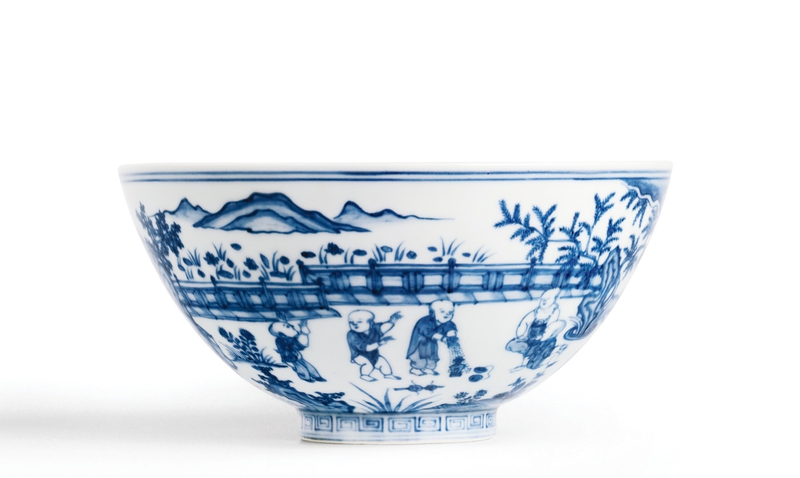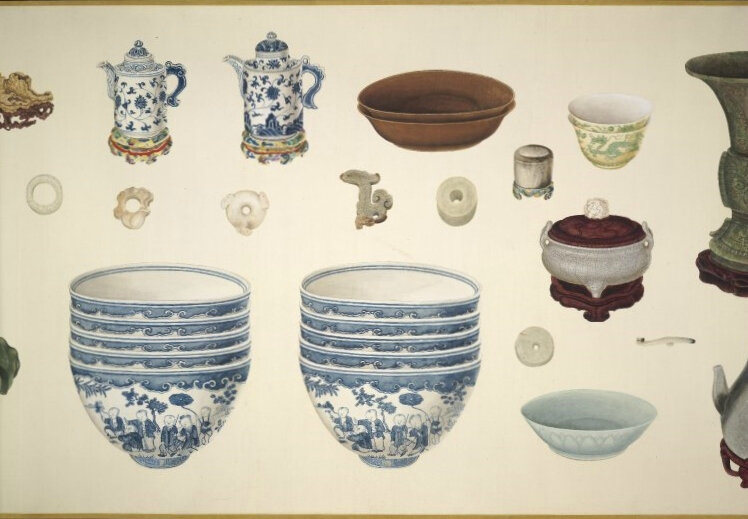An outstanding blue and white 'Boys' Bowl, Ming Dynasty, Interregnum-Chenghua period
Lot 46. An outstanding blue and white 'Boys' Bowl, Ming Dynasty, Interregnum-Chenghua period; 21.4 cm., 8 1/2 in. Estimate 2,600,000 - 3,000,000 HKD. Lot sold 7,820,000 HKD. © Sotheby's 2012
of deep conical form, with slightly rounded sides rising to a wide rim from a straight narrow foot, finely painted on the exterior with a continuous scene showing sixteen boys at play in a garden of flowers, rocks, bamboo and willow, beneath dense curling clouds gathered over half the scene, with four of the boys dressed in short-sleeved jackets and split-pants grouped around a fish bowl trying to catch fish with their hands, while three others pretend to be an official and attendants under a willow tree, one dressed in a long gown, wearing leaves as a cap and riding a hobby horse, followed by two others holding a lotus-leaf umbrella, while another small group in jackets and trousers plays a game on the ground, meanwhile on the other side by a fenced terrace overlooking a lotus-covered lake and distant hills, a group of five depicted in various poses, gesticulating, pouring water over a small toy stupa, or sitting on the ground next to cymbals and a swirling clapper drum, all below a double blue line repeated inside the rim, and above a key-fret border surrounding the foot, the interior of the bowl left plain, the base and inner foot covered with a smooth transparent glaze
Provenance: Collection of President Herbert Hoover (1874-1964) (according to label inscribed H.H. 31).
Collection of Mr. and Mrs. Allan Hoover (son of the above, 1907-1993).
Ralph M. Chait Galleries, New York.
Literature: Regina Krahl, Chinese Ceramics from the Meiyintang Collection, London, 1994-2010, vol. 4, no. 1671.
Note: Bowls of this charming design evoking the ‘Hundred Boys’ topic, although of outstanding quality and clearly imperial, are always unmarked, and their precise dating has been much debated. They are now mostly attributed either to the Chenghua reign (AD 1465-87) or the ‘Interregnum’ period (AD 1436-64) of the three short reigns Zhengtong, Jingtai and Tianshun, the only mid-Ming periods when imaginatively painted porcelains of exquisite quality, but without reign marks, are known to have been made. The design was first developed in the Yongle period (AD 1403-24), as seen in the exhibition catalogue Chinese Porcelain. The S.C. Ko Tianminlou Collection, Hong Kong Museum of Art, Hong Kong, 1987, cat. no. 15; and is also known from examples of Xuande mark and period (AD 1426-35), see Mingdai Xuande guanyao jinghua tezhan tulu/Catalogue of the Special Exhibition of Selected Hsüan-te Imperial Porcelains of the Ming Dynasty, National Palace Museum, Taipei, 1998, no. 152.
Bowls with four different designs of boys at play of Chenghua mark and period have been recovered from the latest Chenghua stratum of the waste heaps of the Ming imperial kilns at Jingdezhen, all related to but different from the present design; see the exhibition catalogue The Emperor’s broken china. Reconstructing Chenghua porcelain, Sotheby’s, London, 1995, cat. nos. 54-7, where two of them are illustrated pp. 52-3 and dust jacket, while the other two are illustrated in the exhibition catalogue A Legacy of Chenghua: Imperial Porcelain of the Chenghua Reign Excavated from Zhushan, Jingdezhen, The Tsui Museum of Art, Hong Kong, 1993, nos. C72 and C73.
Two similar unmarked bowls in the Shanghai Museum are illustrated in Lu Minghua, Shanghai Bowuguan zangpin yanjiu daxi/Studies of the Shanghai Museum Collections : A Series of Monographs. Mingdai guanyao ciqi [Ming imperial porcelain], Shanghai, 2007, pls. 3-55 and 56, attributed to the mid-15th century; another bowl attributed to the Zhengde period (AD 1506-21) is published in Geng Baochang, Ming Qing ciqi jianding [Appraisal of Ming and Qing porcelain], Hong Kong, 1993, p. 117, fig. 220; and one in the British Museum, London, is published in Jessica Harrison-Hall, Ming Ceramics in the British Museum, London, 2001, no. 6: 2, attributed to the Chenghua reign.
Two stacks with a total of ten similar bowls, also of the unmarked type, are depicted in the Guwantu [‘Pictures of Antiques’] handscroll from the collection of Sir Percival David in the British Museum, which records objects from the imperial collection during the Yongzheng reign (AD 1723-35) and is dated in accordance with AD 1728 (fig. 1), see Krahl, op. cit., p. 49, fig. 12.
Guwantu [‘Pictures of Antiques’], detail, ink and colours on paper, handscroll, dated to the 6th year of the Yongzheng period (1728). Formerly Sir Percival David Collection, British Museum, London. © Trustees of the British Museum.
Sotheby's. The Meiyintang Collection, Part IV - An Important Selection of Imperial Chinese Porcelains, Hong Kong, 09 oct. 2012

/https%3A%2F%2Fprofilepics.canalblog.com%2Fprofilepics%2F1%2F0%2F100183.jpg)
/https%3A%2F%2Fstorage.canalblog.com%2F03%2F02%2F119589%2F96711876_o.jpg)
/https%3A%2F%2Fstorage.canalblog.com%2F11%2F31%2F119589%2F94773502_o.jpg)
/https%3A%2F%2Fstorage.canalblog.com%2F20%2F83%2F119589%2F94772815_o.jpg)
/https%3A%2F%2Fstorage.canalblog.com%2F26%2F72%2F119589%2F75604929_o.jpg)
/https%3A%2F%2Fstorage.canalblog.com%2F59%2F60%2F119589%2F26458628_o.jpg)






/image%2F1371349%2F20240416%2Fob_2a8420_437713933-1652609748842371-16764302136.jpg)
/image%2F1371349%2F20240414%2Fob_83ee65_2024-nyr-22642-0954-000-a-blue-and-whi.jpg)
/image%2F1371349%2F20240414%2Fob_15808c_2024-nyr-22642-0953-000-a-blue-and-whi.jpg)
/image%2F1371349%2F20240414%2Fob_e54295_2024-nyr-22642-0952-000-a-rare-blue-an.jpg)